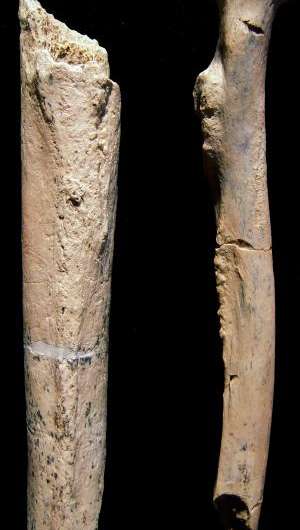Arm bone fragments from a 1.34-million-year-old hominin, Paranthropus boisei, were discovered by an international research team, including a CU Denver anthropologist, in Tanzania. Credit: University of Colorado Denver
A human ancestor characterized by "robust" jaw and skull bones was a muscular creature with a gorilla-like upper body and more adaptive to its environment than previously thought, scientists have discovered.
Researchers found a partial skeleton—including arm, hand, leg and foot fragments—dated to 1.34 million years old and belonging to Paranthropus boisei at the Olduvai Gorge World Heritage fossil site in Tanzania. The find, published in the latest edition of the scientific journal PLOS ONE, represents one of the most recent occurrences of P. boisei before its extinction in East Africa.
"This is the first time we've found bones that suggest that this creature was more ruggedly built—combining terrestrial bipedal locomotion and some arboreal behaviors—than we'd previously thought," said Charles Musiba, Ph.D., associate professor of anthropology at the University of Colorado Denver, part of the international research team. "It seems to have more well-formed forearm muscles that were used for climbing, fine-manipulation and all sorts of behavior."
While P. boisei was known for its massive jaws and cranium—anthropologist Mary Leakey discovered the first skull in 1959 in northern Tanzania—the build and skeletal adaptations of the rest of the archaic hominin's body have been unknown until recently.
During excavations at Olduvai in 2010-2011, the team discovered the partial skeleton of a large adult individual who is represented by various teeth and skeletal parts. Other team members are Manuel Dominguez-Rodrigo, Ph.D., professor of anthropology and prehistory at Complutense University, Madrid; Audax Mabulla, Ph.D., associate professor of archaeology, University of Dar es Salaam, Tanzania, Gail Ashley, Ph.D., professor of geological sciences, Rutgers University; David Uribelarrea, Ph.D. a professor of geology at Complutense University of Madrid; Henry Bunn, Ph.D., professor of anthropology, University of Wisconsin-Madison; and Travis Pickering, Ph.D., professor of anthropology, University of Wisconsin-Madison.
P. boisei was a long-lived species of archaic hominin that first evolved in East Africa about 2.3 million years ago. In the absence of evidence of other skeletal remains, it was commonly assumed that the skeleton of P. boisei was like that of more ancient species of the genus Australopithecus, from which P. boisei likely evolved.
"We are starting to understand the physiology of these individuals of this particular species and how it actually adapted to the kind of habitat it lived in," Musiba said. "We knew about the kind of food it ate—it was omnivorous, leaning more toward plant material—but now we know more: how it walked around and now we know it was a tree climber."
The size of the arm bones suggests strong forearms and a powerful upper body. "It's a different branch on our ancestry tree," Musiba said. "It came later than the other hominins, so the question now is 'what happened to it?' We're going to do more work on biomechanics and see what else this creature was doing."
He noted that the creature likely stood 3.5 to 4.5 feet tall and possessed a robust frame. "We know that it was very strong," Musiba said. "It's unprecedented to find how strong this individual was. The stronger you are the more adaptive you are."
In summer 2014, the bones will be displayed as part of a large exhibit on human origins in Dar es Salaam, Tanzania. The joint-museum exhibit involves the Museum of Human Evolution in Burgos, Spain, the Regional Museum of Archaeology in Madrid, and the National Museum of Dar es Salaam.
With each find scientists are adding to the understanding of how humans evolved and adapted to their surroundings through time. "The more we are finding of these fossils, the more we are learning about the history of these species," Musiba said.
Journal information: PLoS ONE
Provided by University of Colorado Denver
























